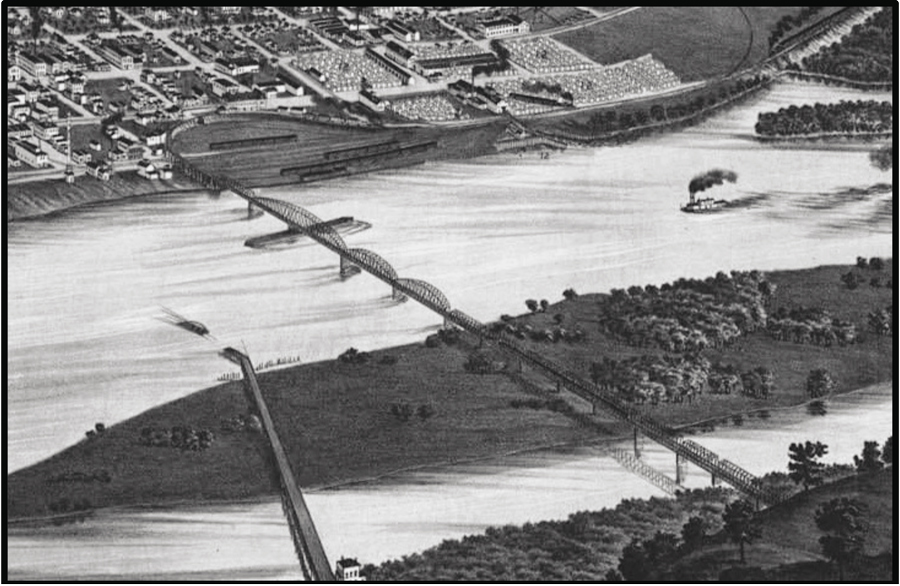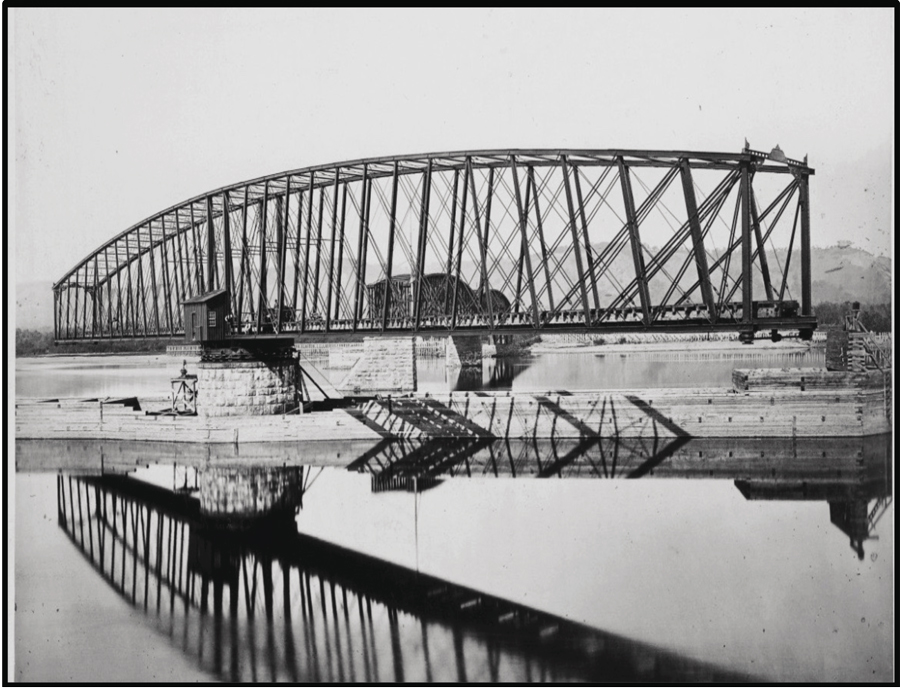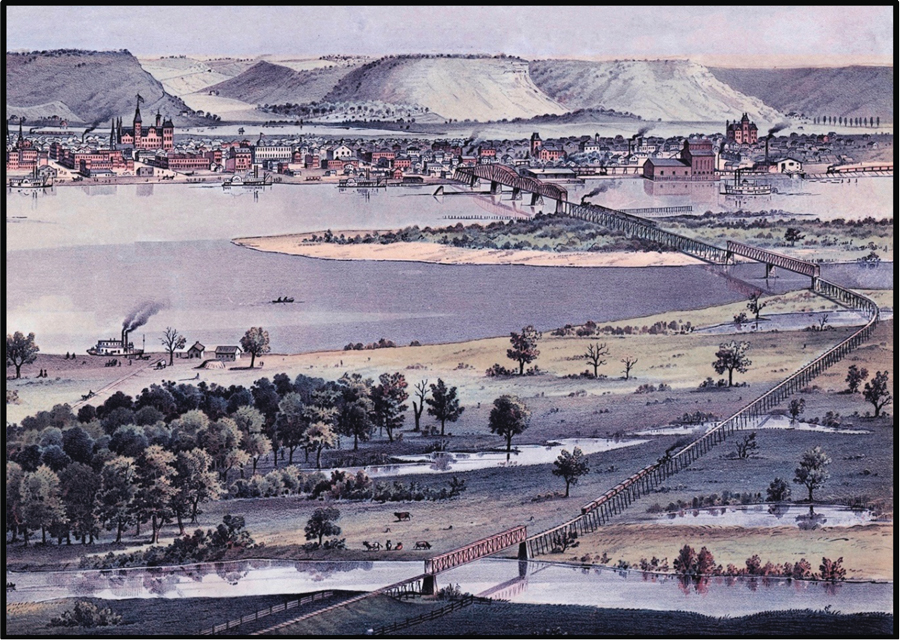Winona bridge, Minnesota/Wisconsin 1871.
The Winona and St. Peter Railroad (originally the Transit Railroad Company) was founded in 1862 and planned to run westerly from Winona on the Mississippi River to St. Peter, about 125 miles away, reaching that point in 1871. From there, it reached Watertown, South Dakota, in 1873. In 1867, it was purchased by the Chicago and North Western Railway that was chartered on June 7, 1859, and from Chicago, it reached the Mississippi at a point in Wisconsin east of Winona, Minnesota, in 1873. It continued its route north to St. Paul, connecting with the Northern Pacific Railroad heading for the West Coast at Puget Sound. However, a bridge connecting the two lines, now under the control of the Chicago and North Western Railway, was needed. After a five-year battle, approval was given to build the bridge in accordance with the 1866 federal law prescribing the requirements for a low-level and a high-level bridge as described for the Quincy and other bridges. Section 8 of the July 25, 1866 Act stated,
And be it further enacted That the Winona and Saint Peter Railroad Company, a corporation existing under the laws of the state of Minnesota, is hereby authorized to construct and operate a railroad bridge across the Mississippi River between the city of Winona in the state of Minnesota and the opposite bank of the said river, in the state of Wisconsin, with the consent of the legislature of the states of Minnesota and Wisconsin and said bridge by this section authorized is hereby declared a post route, and subject to all the terms, restriction and requirement contained in the foregoing sections of this act.

With the approval of Minnesota and Wisconsin, they began the preliminary planning for the bridge. They chose a low-level bridge with a swing bridge, allowing for 160’ clearance between the swing pier and rest piers. Since it was for a low-level bridge, the 1866 Law required a clearance of thirty feet above the low water mark and not less than ten feet above the high water mark. The Winona and St. Peter Railway then ran along the westerly bank of the river just above the water line heading north to Minneapolis. This required a long fill and curved trestle to raise the tracks to the bridge level. Once at the required level, there was a short single 80’ span pony truss followed by a 360’ wooden swing span on the Post pattern. This was followed by two Howe 250’ through trusses with curved top chords. The bridge was 980 feet long across the main channel of the river. This was followed by a trestle across Latsch Island and a three-span Howe through truss over the westerly branch of the Mississippi to Wisconsin. This was followed by a trestle on a curve and a straight line to another Howe through a truss over a slough. The American Bridge Company did not build the portion from the island to touch down in Wisconsin.

The main structure on the bridge was a long wooden swing span near the Winona bank of the river. Since the American Bridge Company from Chicago had adopted the Post Truss for its standard bridge, they chose that pattern for this span with Howe deck and through trusses for the shorter fixed spans. To cut down on costs, they designed the span in wood and iron with the posts inclined towards the center instead of vertically and used a curved top chord in wood.
The bridge was finished on May 26, 1871, and the Winona Republican newspaper wrote, “The bridge is both imposing and symmetrical in its appearance, and it possesses all the strength and solidity that the most scientific combination of stone, iron, and wood, can impart to any structure of the kind.” But on June 1, the St. Cloud Democrat wrote, “The first train of cars crossed the Mississippi last Thursday evening [May 25, 1871]. A grand celebration of the completing of the bridge was to have been today [June 1, 1871], but last Saturday, the eastern half of the draw gave way with a train of six flat cars loaded with stone…The length of the draw was 360 feet, and the portion which gave way was on the Wisconsin side about 180 feet long. The bridge had not been fully adjusted and had not been accepted by the railroad company.” Another paper wrote in part, “One must be horrified when he contemplates what would have been the awful spectacle had been away with the passenger train scheduled few hours before instead of the freight train as it did. If the company from Chicago which built the Winona Bridge was guilty of deception or careless work, they ought to smoke for it and be driven out of their homes. We are cursed with work of this kind.” Another paper wrote, “It was the frailest thing, the smallest piers and cheapest structure on the river, costing only $130,000 while the magnificent Dubuque bridge cost $600,000.” It was discovered that the bridge builder was not fully responsible for the failure, and the bridge tender, new to his job, had not properly closed the bridge, and the train derailed, causing the failure. The American Bridge Company rebuilt the swing span in iron, and it was swung on January 13, 1872. On January 21, 1872, the bridge was reopened for traffic.

The Bridge Company had an advertisement prepared with the image above that gave the following data on their bridge, “Swing span, Post’s Patent Diagonal Iron Truss, with [steam] engine, 360 feet; Fixed spans Howe Truss Arched Top chords 250 feet each; Fixed Howe Truss 80 feet. Total length of bridge over main channel, 940 feet.” The American Bridge Company went out of business in 1878 after a failure of their attempt to build a bridge across the Hudson River at Poughkeepsie, New York.
The swing span was replaced in 1899, and the rest of the bridge was replaced over time with a series of plate girder spans over much of its length. The bridge was abandoned in 1977. A portion of the plate girder spans remain in place.■
